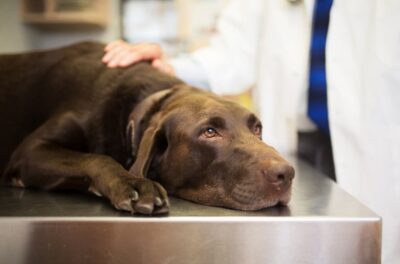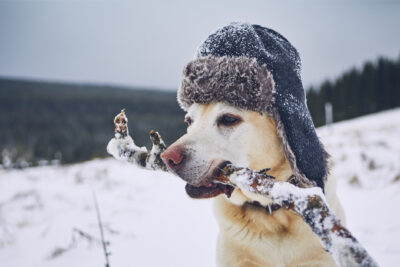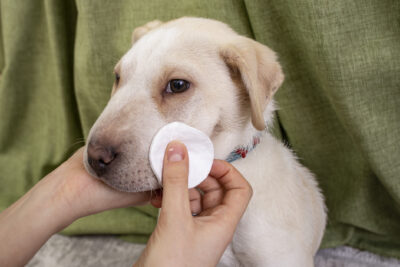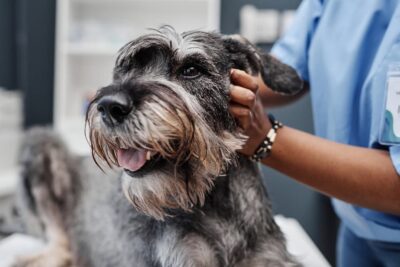Can Dogs Get Dandruff?

When we think about dandruff, our minds typically go to how it impacts humans: itching, discomfort, and embarrassment. But what about your dog? You might be noticing white flakes on their coat and a trail of specks on the dog bed, sofa, and carpet, leaving you wondering – can dogs get dandruff?
In this article, we’ll provide a better understanding of dog dandruff – including the possible causes and treatment options – giving you the tools to offer your dog relief from the itchy condition.
Can Dogs Get Dandruff?
As you may have guessed, the answer is yes, those white flakes you’re seeing on your pup could be dandruff. In fact, dog dandruff is common, according to Dr. Jennifer Frione, veterinarian and owner of Lakeside Animal Hospital in Plantation, Florida.
The condition, also known as seborrhea, occurs when the sebaceous (oil) glands in the skin produce too much oil, leading to dry, red, inflamed, and itchy skin. “Dandruff appears as flakes of dead skin cells on the coat,” Frione says.
Despite the ick factor, dog dandruff isn’t a serious medical condition – but it can be uncomfortable. Skin irritation and itching are common when your dog has dandruff, and it can cause them to scratch excessively, which can lead to hair loss.
It’s possible for dandruff to appear anywhere on your dog’s body, but it tends to be more common along their back. Dandruff can also cause red, inflamed skin, especially in areas with skin folds, including the feet, thighs, bellies, armpits, neck, and lips.
In some breeds, including Basset Hounds, American Cocker Spaniels, English Springer Spaniels, Dachshunds, Golden Retrievers and West Highland White Terriers, dog dandruff can be an inherited condition. If dandruff is inherited, the symptoms usually appear when dogs are 18 to 24 months of age and last throughout their lives.
What About Puppy Dandruff?
Puppies can get dandruff as well. In fact, they may be more prone to dandruff than older dogs. The reason: their sebaceous glands are still developing and need time to regulate.
Dog Dandruff: What Does it Look Like?

Dog dandruff can appear as white, flaky scales on the coat, according to Dr. Frione. The white flakes “tend to be more prominent [along] the back and can often have red and itchy skin associated with it,” she adds.
Dandruff is easier to spot in dogs with short, dark coats and harder to see on dogs with long, light hair, including white hair, that can camouflage the flakes.
Why Does My Dog Have Dandruff? Causes to Consider
When a dog has dandruff, veterinarians will do an exam to check for things like oiliness in the skin, odor, texture of the skin and coat, and degree of flakiness to figure out what’s causing the flakes, redness, and irritation.
Your vet will diagnose “primary seborrhea” if the dandruff appears to be inherited or genetic. If it’s not an inherited condition, it’s considered “secondary seborrhea,” which means another medical condition is causing dog dandruff.
6 Common Possible Causes of Dog Dandruff
Hormonal disorders. Certain diseases that cause hormone imbalances, including hypothyroidism and Cushing’s disease, can lead to dry, flaky skin. This dog dandruff typically appears in middle-aged or older dogs who have flaking skin but aren’t super itchy.
Allergies. Dogs who are diagnosed with dandruff before they are five years old may have allergies.
Infections. Both bacterial infections and fungal infections, including yeast infections on the skin, can cause dog dandruff. When dandruff occurs alongside symptoms like boils, pimples or other bumps on the skin, it could be a sign of a bacterial infection.
Nutrition deficiencies. Dandruff in dogs is often a side effect of a diet that doesn’t contain enough Omega-3 fatty acids.
Obesity. When dogs are too overweight to groom themselves, it can cause oil to build up on the skin and lead to dandruff.
Environmental factors. Changes in temperature and humidity can cause changes in your dog’s skin.
Given that there are a number of potential causes of dog dandruff, it’s important to schedule an appointment with your veterinarian to get an accurate diagnosis and treatment plan.
They may recommend a blood test, hormone tests, and skin scraping, culture or biopsy to help diagnose the cause of dandruff.
Walking Dandruff
Interestingly, sometimes dandruff is not dandruff at all, meaning the white “flakes” you see on your puppy or adult dog are actually parasites. The condition is called walking dandruff.
“Walking dandruff, or Cheyletiellosis, is a skin parasite that affects dogs, cats, rabbits, and even humans,” Dr. Frione says. “It’s not very common, but it is very contagious and is characterized as large white mites ‘walking’ on the coat. The condition causes excessive scaling and itchiness.”
How to Get Rid of Dog Dandruff: Treatment Options
There is no one-size-fits-all dog dandruff treatment. “The treatment depends on the cause and should be tailored to the underlying condition,” says Dr. Frione.
Often, treating bacterial or fungal infections, changing diet, losing weight, or treating allergies will cause dandruff to disappear. When dog dandruff is genetic, treating the symptoms to provide itch relief and prevent secondary infections is the best option.
Your vet may recommend one (or more) of these treatments:
- Omega-3 fatty acid supplements
- Medicated shampoos to alleviate dry skin and itchiness
- Prescription corticosteroid medications
- Antibiotics for bacterial infections
- Antifungal medications
- Parasite treatment to kill mites (walking dandruff)
Pet owners have tried a variety of home remedies for dog dandruff and itching. For example, bathing your dog in a 50/50 mixture of apple cider vinegar and water is said to help soothe some itching. However, home remedies can also cause skin conditions to worsen. Therefore, it’s important to consult your veterinarian before trying any home remedies.
It’s also important to note that you should never treat dog dandruff with non-pet dandruff products. Be sure to skip any dandruff treatments meant for humans, including shampoos. Some human supplements and medications contain ingredients that are toxic to dogs, and dandruff shampoos that weren’t made for pets could make their skin even more red and irritated.
Can You Prevent Dog Dandruff?
No one wants their dog to live with red, flaky, inflamed skin and/or irritation and itchiness. These strategies can help prevent dog dandruff:
Good grooming. Brushing your dog not only removes dead hair; it also helps distribute the oil across their skin and coat, which could reduce dandruff.
Proper diet. Commercial dog diets contain all of the nutrients your dog needs for a healthy skin and coat. Your veterinarian may recommend dog food that has a fish protein, which is higher in Omega-3 fatty acids, to see if it helps alleviate itchy, flaky skin.
Weight loss. A dog that is too obese to groom themselves isn’t able to spread the oils from their sebaceous glands throughout their skin and coat or remove excess hair. Talk to your veterinarian about a safe weight management approach.









